AASB 101 & AASB 112: Inventory and Costing at XRF Scientific LTD
VerifiedAdded on 2023/04/20
|6
|1340
|123
Essay
AI Summary
This essay provides an analysis of inventory management and costing methods at XRF Scientific LTD, focusing on compliance with AASB 101 and AASB 112. It evaluates the company's inventory measurement, identifies the safety stock method used and its advantages, determines the weighted average costing method, and estimates the impact of different costing methods on the company's financial statements. The essay highlights that XRF Scientific LTD adheres to AASB standards, ensuring accurate inventory presentation in its financial statements, and emphasizes the importance of maintaining optimal inventory levels for better financial forecasting. Desklib provides access to similar solved assignments for students.
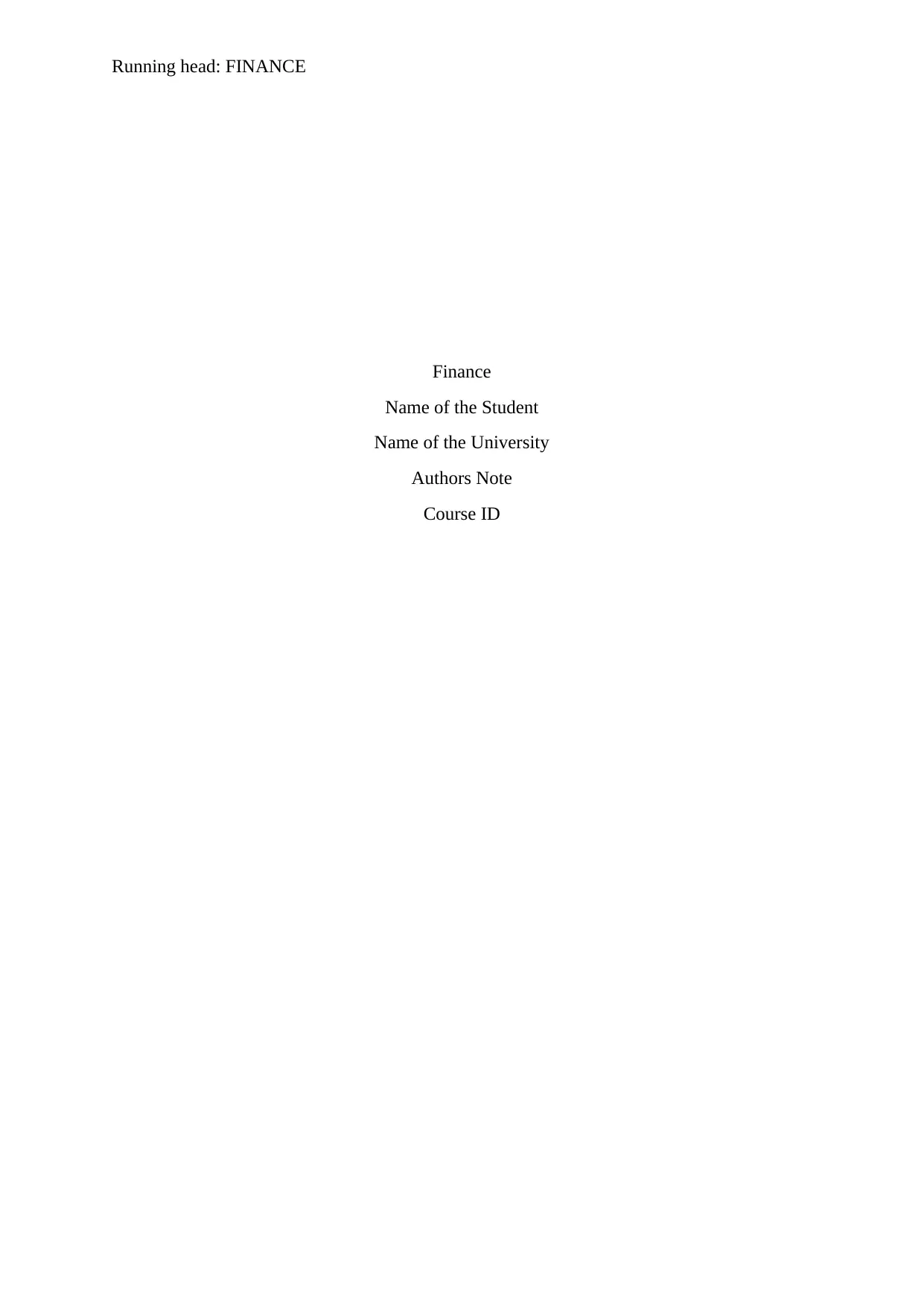
Running head: FINANCE
Finance
Name of the Student
Name of the University
Authors Note
Course ID
Finance
Name of the Student
Name of the University
Authors Note
Course ID
Paraphrase This Document
Need a fresh take? Get an instant paraphrase of this document with our AI Paraphraser
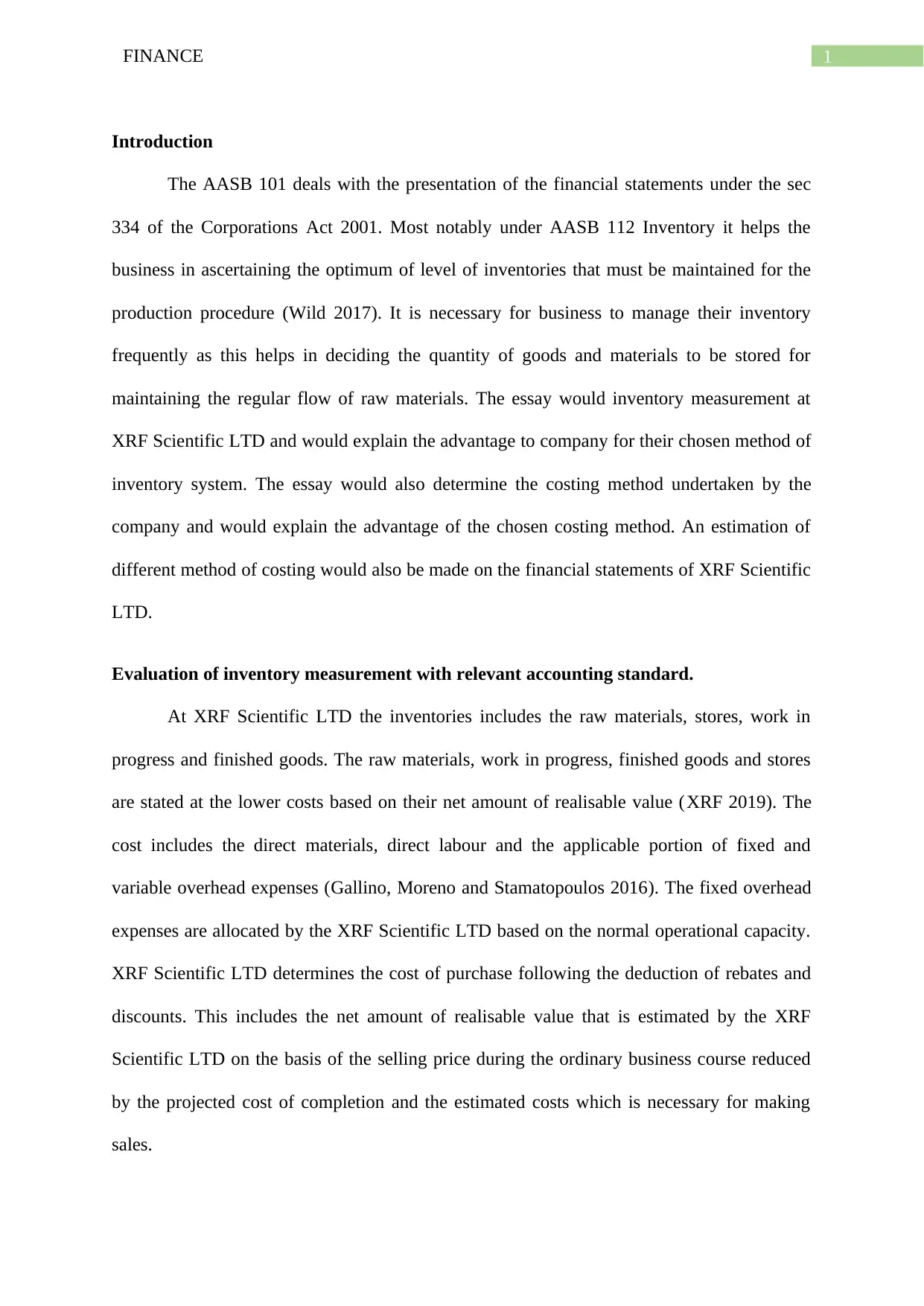
1FINANCE
Introduction
The AASB 101 deals with the presentation of the financial statements under the sec
334 of the Corporations Act 2001. Most notably under AASB 112 Inventory it helps the
business in ascertaining the optimum of level of inventories that must be maintained for the
production procedure (Wild 2017). It is necessary for business to manage their inventory
frequently as this helps in deciding the quantity of goods and materials to be stored for
maintaining the regular flow of raw materials. The essay would inventory measurement at
XRF Scientific LTD and would explain the advantage to company for their chosen method of
inventory system. The essay would also determine the costing method undertaken by the
company and would explain the advantage of the chosen costing method. An estimation of
different method of costing would also be made on the financial statements of XRF Scientific
LTD.
Evaluation of inventory measurement with relevant accounting standard.
At XRF Scientific LTD the inventories includes the raw materials, stores, work in
progress and finished goods. The raw materials, work in progress, finished goods and stores
are stated at the lower costs based on their net amount of realisable value (XRF 2019). The
cost includes the direct materials, direct labour and the applicable portion of fixed and
variable overhead expenses (Gallino, Moreno and Stamatopoulos 2016). The fixed overhead
expenses are allocated by the XRF Scientific LTD based on the normal operational capacity.
XRF Scientific LTD determines the cost of purchase following the deduction of rebates and
discounts. This includes the net amount of realisable value that is estimated by the XRF
Scientific LTD on the basis of the selling price during the ordinary business course reduced
by the projected cost of completion and the estimated costs which is necessary for making
sales.
Introduction
The AASB 101 deals with the presentation of the financial statements under the sec
334 of the Corporations Act 2001. Most notably under AASB 112 Inventory it helps the
business in ascertaining the optimum of level of inventories that must be maintained for the
production procedure (Wild 2017). It is necessary for business to manage their inventory
frequently as this helps in deciding the quantity of goods and materials to be stored for
maintaining the regular flow of raw materials. The essay would inventory measurement at
XRF Scientific LTD and would explain the advantage to company for their chosen method of
inventory system. The essay would also determine the costing method undertaken by the
company and would explain the advantage of the chosen costing method. An estimation of
different method of costing would also be made on the financial statements of XRF Scientific
LTD.
Evaluation of inventory measurement with relevant accounting standard.
At XRF Scientific LTD the inventories includes the raw materials, stores, work in
progress and finished goods. The raw materials, work in progress, finished goods and stores
are stated at the lower costs based on their net amount of realisable value (XRF 2019). The
cost includes the direct materials, direct labour and the applicable portion of fixed and
variable overhead expenses (Gallino, Moreno and Stamatopoulos 2016). The fixed overhead
expenses are allocated by the XRF Scientific LTD based on the normal operational capacity.
XRF Scientific LTD determines the cost of purchase following the deduction of rebates and
discounts. This includes the net amount of realisable value that is estimated by the XRF
Scientific LTD on the basis of the selling price during the ordinary business course reduced
by the projected cost of completion and the estimated costs which is necessary for making
sales.
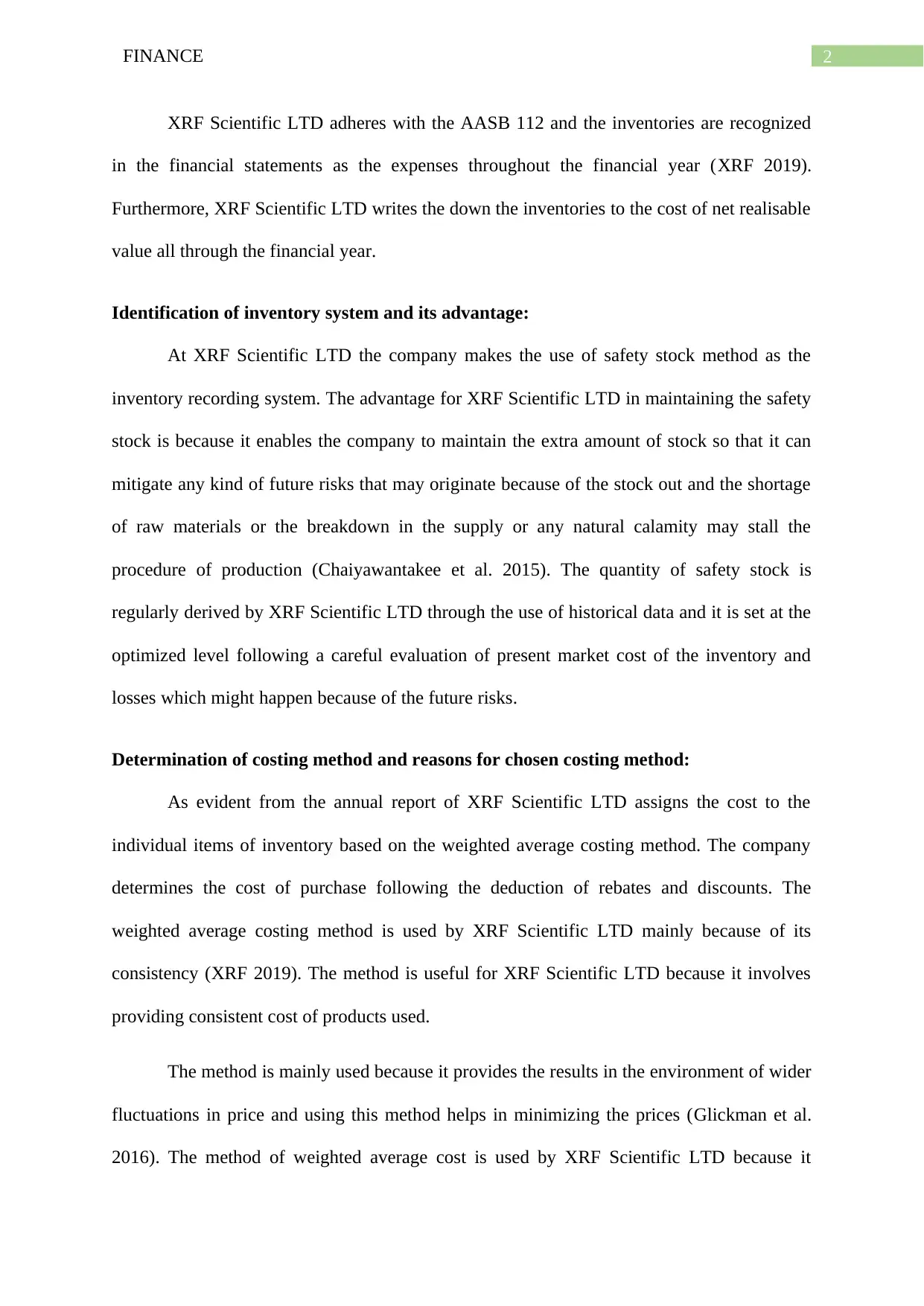
2FINANCE
XRF Scientific LTD adheres with the AASB 112 and the inventories are recognized
in the financial statements as the expenses throughout the financial year (XRF 2019).
Furthermore, XRF Scientific LTD writes the down the inventories to the cost of net realisable
value all through the financial year.
Identification of inventory system and its advantage:
At XRF Scientific LTD the company makes the use of safety stock method as the
inventory recording system. The advantage for XRF Scientific LTD in maintaining the safety
stock is because it enables the company to maintain the extra amount of stock so that it can
mitigate any kind of future risks that may originate because of the stock out and the shortage
of raw materials or the breakdown in the supply or any natural calamity may stall the
procedure of production (Chaiyawantakee et al. 2015). The quantity of safety stock is
regularly derived by XRF Scientific LTD through the use of historical data and it is set at the
optimized level following a careful evaluation of present market cost of the inventory and
losses which might happen because of the future risks.
Determination of costing method and reasons for chosen costing method:
As evident from the annual report of XRF Scientific LTD assigns the cost to the
individual items of inventory based on the weighted average costing method. The company
determines the cost of purchase following the deduction of rebates and discounts. The
weighted average costing method is used by XRF Scientific LTD mainly because of its
consistency (XRF 2019). The method is useful for XRF Scientific LTD because it involves
providing consistent cost of products used.
The method is mainly used because it provides the results in the environment of wider
fluctuations in price and using this method helps in minimizing the prices (Glickman et al.
2016). The method of weighted average cost is used by XRF Scientific LTD because it
XRF Scientific LTD adheres with the AASB 112 and the inventories are recognized
in the financial statements as the expenses throughout the financial year (XRF 2019).
Furthermore, XRF Scientific LTD writes the down the inventories to the cost of net realisable
value all through the financial year.
Identification of inventory system and its advantage:
At XRF Scientific LTD the company makes the use of safety stock method as the
inventory recording system. The advantage for XRF Scientific LTD in maintaining the safety
stock is because it enables the company to maintain the extra amount of stock so that it can
mitigate any kind of future risks that may originate because of the stock out and the shortage
of raw materials or the breakdown in the supply or any natural calamity may stall the
procedure of production (Chaiyawantakee et al. 2015). The quantity of safety stock is
regularly derived by XRF Scientific LTD through the use of historical data and it is set at the
optimized level following a careful evaluation of present market cost of the inventory and
losses which might happen because of the future risks.
Determination of costing method and reasons for chosen costing method:
As evident from the annual report of XRF Scientific LTD assigns the cost to the
individual items of inventory based on the weighted average costing method. The company
determines the cost of purchase following the deduction of rebates and discounts. The
weighted average costing method is used by XRF Scientific LTD mainly because of its
consistency (XRF 2019). The method is useful for XRF Scientific LTD because it involves
providing consistent cost of products used.
The method is mainly used because it provides the results in the environment of wider
fluctuations in price and using this method helps in minimizing the prices (Glickman et al.
2016). The method of weighted average cost is used by XRF Scientific LTD because it
⊘ This is a preview!⊘
Do you want full access?
Subscribe today to unlock all pages.

Trusted by 1+ million students worldwide
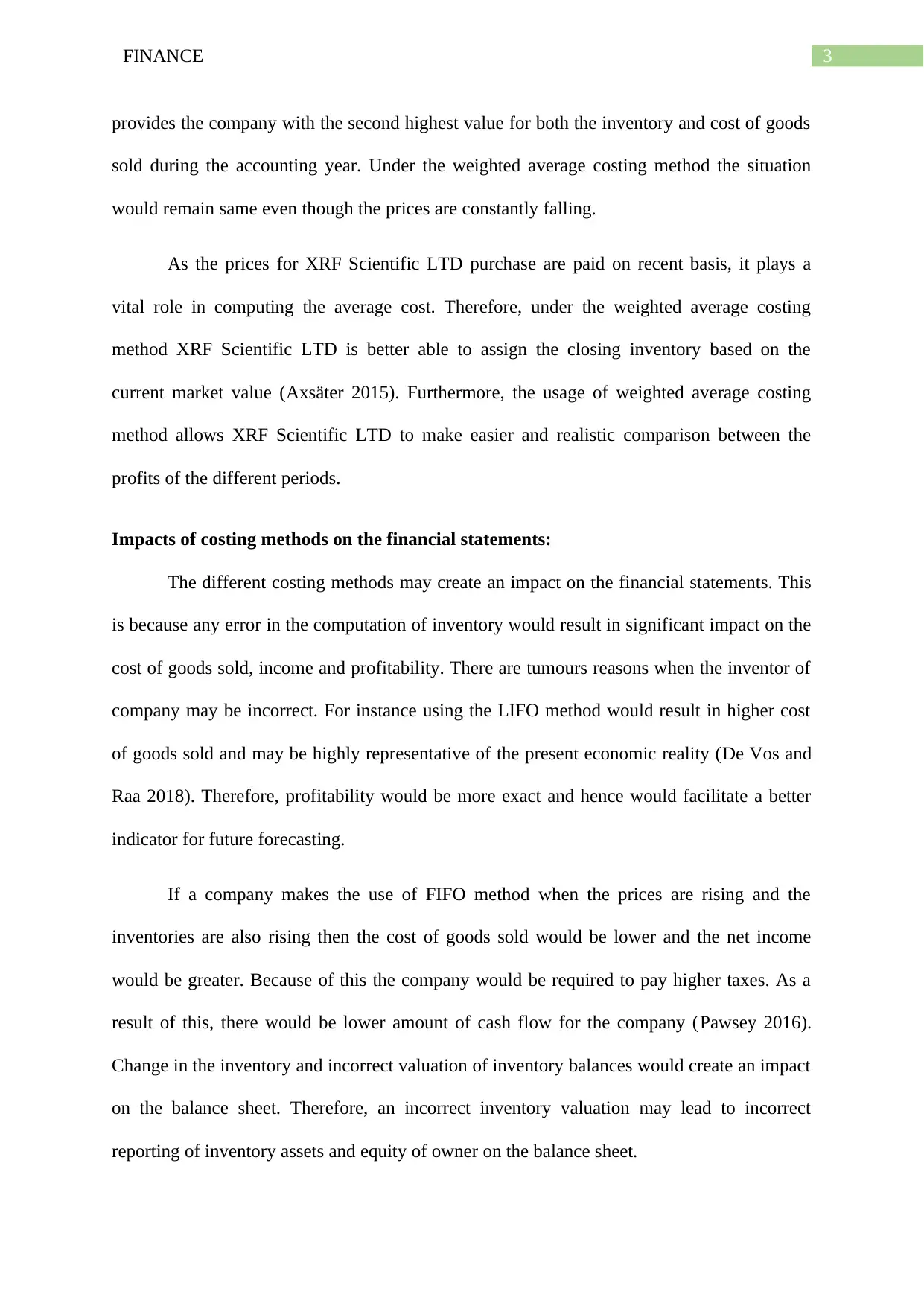
3FINANCE
provides the company with the second highest value for both the inventory and cost of goods
sold during the accounting year. Under the weighted average costing method the situation
would remain same even though the prices are constantly falling.
As the prices for XRF Scientific LTD purchase are paid on recent basis, it plays a
vital role in computing the average cost. Therefore, under the weighted average costing
method XRF Scientific LTD is better able to assign the closing inventory based on the
current market value (Axsäter 2015). Furthermore, the usage of weighted average costing
method allows XRF Scientific LTD to make easier and realistic comparison between the
profits of the different periods.
Impacts of costing methods on the financial statements:
The different costing methods may create an impact on the financial statements. This
is because any error in the computation of inventory would result in significant impact on the
cost of goods sold, income and profitability. There are tumours reasons when the inventor of
company may be incorrect. For instance using the LIFO method would result in higher cost
of goods sold and may be highly representative of the present economic reality (De Vos and
Raa 2018). Therefore, profitability would be more exact and hence would facilitate a better
indicator for future forecasting.
If a company makes the use of FIFO method when the prices are rising and the
inventories are also rising then the cost of goods sold would be lower and the net income
would be greater. Because of this the company would be required to pay higher taxes. As a
result of this, there would be lower amount of cash flow for the company (Pawsey 2016).
Change in the inventory and incorrect valuation of inventory balances would create an impact
on the balance sheet. Therefore, an incorrect inventory valuation may lead to incorrect
reporting of inventory assets and equity of owner on the balance sheet.
provides the company with the second highest value for both the inventory and cost of goods
sold during the accounting year. Under the weighted average costing method the situation
would remain same even though the prices are constantly falling.
As the prices for XRF Scientific LTD purchase are paid on recent basis, it plays a
vital role in computing the average cost. Therefore, under the weighted average costing
method XRF Scientific LTD is better able to assign the closing inventory based on the
current market value (Axsäter 2015). Furthermore, the usage of weighted average costing
method allows XRF Scientific LTD to make easier and realistic comparison between the
profits of the different periods.
Impacts of costing methods on the financial statements:
The different costing methods may create an impact on the financial statements. This
is because any error in the computation of inventory would result in significant impact on the
cost of goods sold, income and profitability. There are tumours reasons when the inventor of
company may be incorrect. For instance using the LIFO method would result in higher cost
of goods sold and may be highly representative of the present economic reality (De Vos and
Raa 2018). Therefore, profitability would be more exact and hence would facilitate a better
indicator for future forecasting.
If a company makes the use of FIFO method when the prices are rising and the
inventories are also rising then the cost of goods sold would be lower and the net income
would be greater. Because of this the company would be required to pay higher taxes. As a
result of this, there would be lower amount of cash flow for the company (Pawsey 2016).
Change in the inventory and incorrect valuation of inventory balances would create an impact
on the balance sheet. Therefore, an incorrect inventory valuation may lead to incorrect
reporting of inventory assets and equity of owner on the balance sheet.
Paraphrase This Document
Need a fresh take? Get an instant paraphrase of this document with our AI Paraphraser
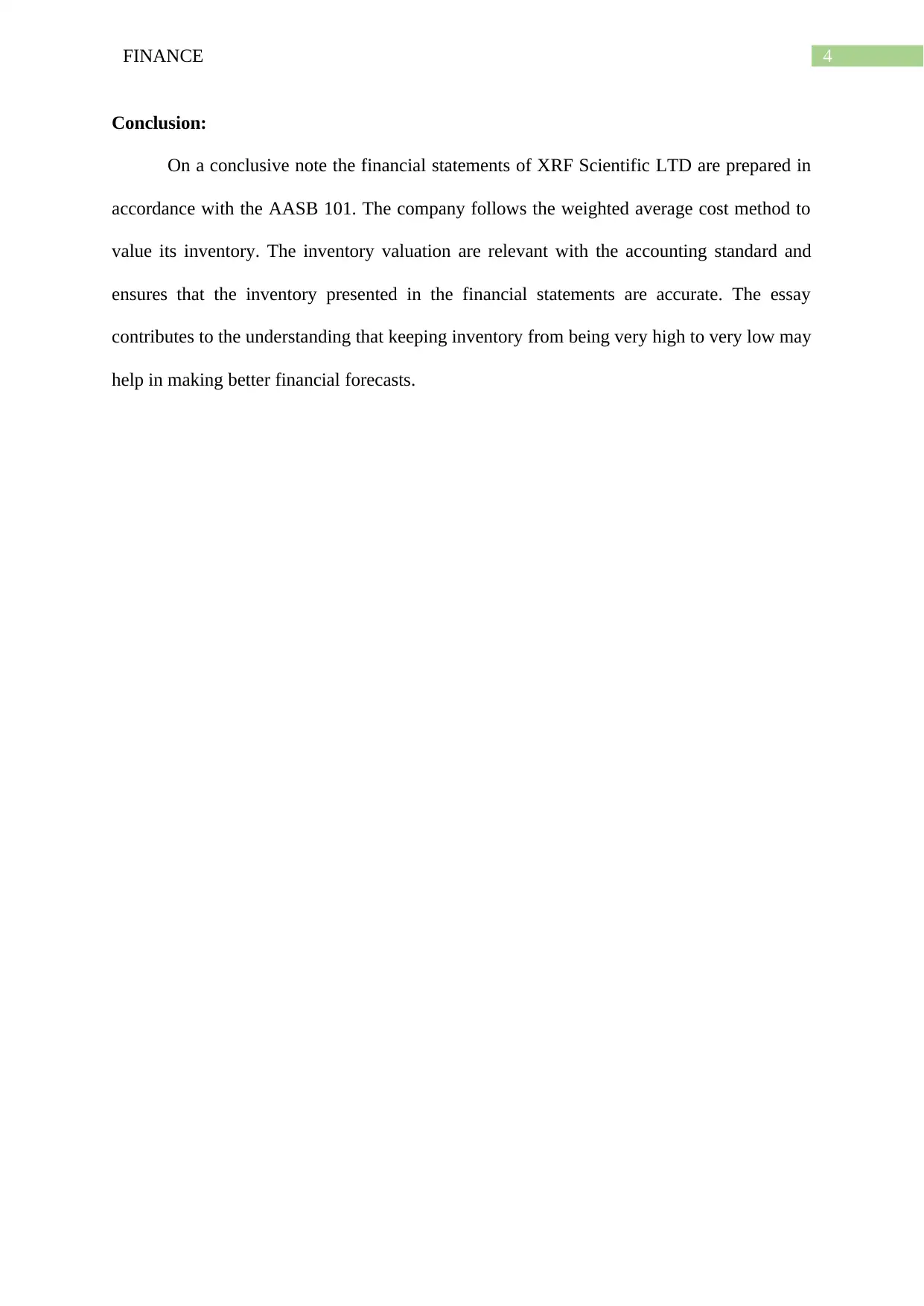
4FINANCE
Conclusion:
On a conclusive note the financial statements of XRF Scientific LTD are prepared in
accordance with the AASB 101. The company follows the weighted average cost method to
value its inventory. The inventory valuation are relevant with the accounting standard and
ensures that the inventory presented in the financial statements are accurate. The essay
contributes to the understanding that keeping inventory from being very high to very low may
help in making better financial forecasts.
Conclusion:
On a conclusive note the financial statements of XRF Scientific LTD are prepared in
accordance with the AASB 101. The company follows the weighted average cost method to
value its inventory. The inventory valuation are relevant with the accounting standard and
ensures that the inventory presented in the financial statements are accurate. The essay
contributes to the understanding that keeping inventory from being very high to very low may
help in making better financial forecasts.
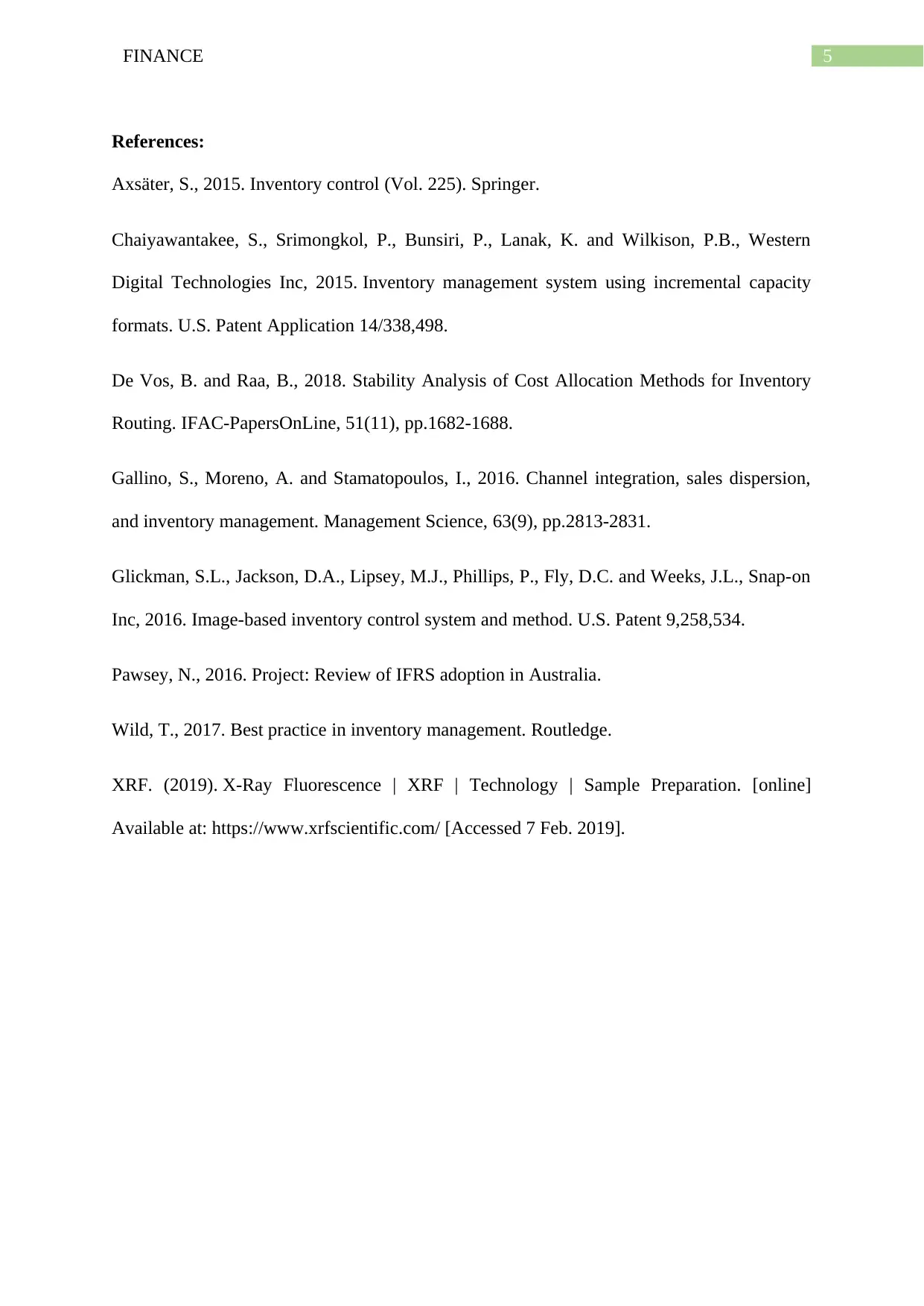
5FINANCE
References:
Axsäter, S., 2015. Inventory control (Vol. 225). Springer.
Chaiyawantakee, S., Srimongkol, P., Bunsiri, P., Lanak, K. and Wilkison, P.B., Western
Digital Technologies Inc, 2015. Inventory management system using incremental capacity
formats. U.S. Patent Application 14/338,498.
De Vos, B. and Raa, B., 2018. Stability Analysis of Cost Allocation Methods for Inventory
Routing. IFAC-PapersOnLine, 51(11), pp.1682-1688.
Gallino, S., Moreno, A. and Stamatopoulos, I., 2016. Channel integration, sales dispersion,
and inventory management. Management Science, 63(9), pp.2813-2831.
Glickman, S.L., Jackson, D.A., Lipsey, M.J., Phillips, P., Fly, D.C. and Weeks, J.L., Snap-on
Inc, 2016. Image-based inventory control system and method. U.S. Patent 9,258,534.
Pawsey, N., 2016. Project: Review of IFRS adoption in Australia.
Wild, T., 2017. Best practice in inventory management. Routledge.
XRF. (2019). X-Ray Fluorescence | XRF | Technology | Sample Preparation. [online]
Available at: https://www.xrfscientific.com/ [Accessed 7 Feb. 2019].
References:
Axsäter, S., 2015. Inventory control (Vol. 225). Springer.
Chaiyawantakee, S., Srimongkol, P., Bunsiri, P., Lanak, K. and Wilkison, P.B., Western
Digital Technologies Inc, 2015. Inventory management system using incremental capacity
formats. U.S. Patent Application 14/338,498.
De Vos, B. and Raa, B., 2018. Stability Analysis of Cost Allocation Methods for Inventory
Routing. IFAC-PapersOnLine, 51(11), pp.1682-1688.
Gallino, S., Moreno, A. and Stamatopoulos, I., 2016. Channel integration, sales dispersion,
and inventory management. Management Science, 63(9), pp.2813-2831.
Glickman, S.L., Jackson, D.A., Lipsey, M.J., Phillips, P., Fly, D.C. and Weeks, J.L., Snap-on
Inc, 2016. Image-based inventory control system and method. U.S. Patent 9,258,534.
Pawsey, N., 2016. Project: Review of IFRS adoption in Australia.
Wild, T., 2017. Best practice in inventory management. Routledge.
XRF. (2019). X-Ray Fluorescence | XRF | Technology | Sample Preparation. [online]
Available at: https://www.xrfscientific.com/ [Accessed 7 Feb. 2019].
⊘ This is a preview!⊘
Do you want full access?
Subscribe today to unlock all pages.

Trusted by 1+ million students worldwide
1 out of 6
Related Documents
Your All-in-One AI-Powered Toolkit for Academic Success.
+13062052269
info@desklib.com
Available 24*7 on WhatsApp / Email
![[object Object]](/_next/static/media/star-bottom.7253800d.svg)
Unlock your academic potential
Copyright © 2020–2025 A2Z Services. All Rights Reserved. Developed and managed by ZUCOL.




